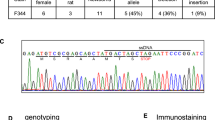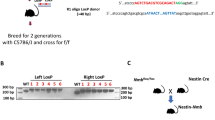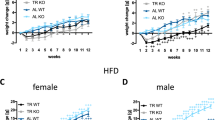Abstract
Neuropeptide Y (NPY) is a 36-amino-acid neurotransmitter which is widely distributed throughout the central and peripheral nervous system1. NPY involvement has been suggested in various physiological responses including cardiovascular homeostasis2 and the hypothalamic control of food intake3. At least six subtypes of NPY receptors have been described4,5. Because of the lack of selective antagonists, the specific role of each receptor subtype has been difficult to establish. Here we describe mice deficient for the expression of the Y1 receptor subtype. Homozygous mutant mice demonstrate a complete absence of blood pressure response to NPY, whereas they retain normal response to other vasoconstrictors. Daily food intake, as well as NPY-stimulated feeding, are only slightly diminished, whereas fast-induced refeeding is markedly reduced. Adult mice lacking the NPY Y1 receptor are characterized by increased body fat with no change in protein content. The higher energetic efficiency of mutant mice might result, in part, from the lower metabolic rate measured during the active period, associated with reduced locomotor activity. These results demonstrate the importance of NPY Y1 receptors in NPY-mediated cardiovascular response and in the regulation of body weight through central control of energy expenditure. In addition, these data are also indicative of a role for the Y1 receptor in the control of food intake.
This is a preview of subscription content, access via your institution
Access options
Subscribe to this journal
Receive 12 print issues and online access
$209.00 per year
only $17.42 per issue
Buy this article
- Purchase on Springer Link
- Instant access to full article PDF
Prices may be subject to local taxes which are calculated during checkout
Similar content being viewed by others
References
Dumont, Y., Martel, J.C., Fournier, A., St-Pierre, S. & Quirion, R. Neuropeptide Y and neuropeptide Y receptor subtypes in brain and peripheral tissues. Prog. Neurobiol. 38, 125–167 (1992).
Grundemar, L. & Hakanson, R. Multiple neuropeptide y receptors are involved in cardiovascular regulation. Peripheral and central mechanisms. Gen. Pharmacol. 24, 785–796 (1993).
Stanley, B.G., Kyrkouli, S.E., Lampert, S. & Leibowitz, S.F. Neuropeptide Y chronically injected into the hypothalamus: a powerful neurochemical inducer of hyperphagia and obesity. Peptides 7, 1189–1192 (1989).
Blomqvist, A.G. & Herzog, H. Y-receptor subtypes: how many more? Trends Neurosci. 20, 294–298 (1997).
Balasubramaniam, A.A. Neuropeptide Y family of hormones: receptor subtypes and antagonists. Peptides 18, 445–457 (1997).
Eva, C., Oberto, A., Sprengel, R. & Genazzani, E. The murine NPY-1 receptor gene. Structure and delineation of tissue-specific expression. FEBS Lett. 314, 285–288 (1992).
Rudolf, K. et al. The first highly potent and selective non-peptide neuropeptide Y Y1 receptor antagonist: BIBP3226. Eur. J. Pharmacol. 271, R11–R13 (1994).
Edvinsson, L., Ekblad, E., Hakanson, R. & Wahlestedt, C. Neuropeptide Y potentiates the effect of various vasoconstrictor agents on rabbit blood vessels. Br. J. Pharmacol. 83, 519–525 (1984).
Nilsson, T., You, J., Hedner, T. & Edvinsson, L. Characterization of neuropeptide Y receptors mediating contraction, potentiation and inhibition of relaxation. Blood Pressure 5, 164–169 (1996).
Wahlestedt, C., Hakanson, R., Vaz, C.A. & Zukowska-Grojec, Z. Norepinephrine and neuropeptide Y: vasoconstrictor cooperation in vivo and in vitro. Am. J. Physiol. 258, R736–R742 (1990).
Stephens, T.W. et al. The role of neuropeptide Y in the antiobesity action of the obese gene product. Nature 377, 530–532 (1995).
Erickson, J.C., Hollopeter, G. & Palmiter, R.D. Attenuation of the obesity syndrome of ob/ob mice by the loss of neuropeptide Y. Science 274, 1704–1707 (1996).
Kanatani, A. et al. Potent neuropeptide Y Y1 receptor antagonist, 1229U91: Blockade of neuropeptide Y-induced and physiological food intake. Endocrinology 137, 3177–3182 (1996).
Schaffhauser, A.O. et al. Inhibition of food intake by neuropeptide Y Y5 receptor anti-sense oligodeoxynucleotides. Diabetes 46, 1792–1798 (1997).
O'Shea, D. et al. Neuropeptide Y induced feeding in the rat is mediated by a novel receptor. Endocrinology 138, 196–202 (1997).
Morley, J.E., Hernandez, E.N. & Flood, J.F. Neuropeptide Y increases food intake in mice. Am. J. Physiol. 253, R516–R522 (1987).
Girardier, L., Clark, M.G. & Seydoux, J. Thermogenesis associated with spontaneous activity: an important component of thermoregulatory needs in rats. J. Physiol. 488, 779–787 (1995).
Erickson, J.C., Clegg, K.E. & Palmiter, R.D. Sensitivity to leptin and susceptibility to seizures of mice lacking neuropeptide Y. Nature 381, 415–418 (1996).
Selfridge, J., Pow, A.M., McWhir, J., Magin, T.M. & Melton, D.W. Gene targeting using a mouse HPRT minigene/HPRT-deficient embryonic stem cell system: inactivation of the mouse ERCC-1 gene. Somat. Cell Mol. Genet. 18, 325–336 (1992).
Martel, J.C. et al. Comperative structural requirements of brain neuropeptide Y binding sites and vas deferens neuropeptide Y receptors. Mol.Pharmacol. 38, 494–502 (1990).
Wiesel, P., Mazzolai, L., Nussberger, J. & Pedrazzini, T. Two-kidney, One Clip and One-Kidney, One Clip Hypertension in Mice. Hypertension 29, 1025–1030 (1997).
Mulvany, M.J., & Halpern, W. Mechanical properties of vascular smooth muscle cells in situ. Nature 260, 617–619 (1976).
Entenman, C. in Methods in Enzymology (eds Colowick, S.P. & Kaplan, O.) 299–317 (Academic Press, New-York, 1957).
Grouzmann, E., Aubert, J.F., Waeber, B. & Brunner, H.R. A sensitive and specific two-site, sandwich-amplified enzyme immunoassay for neuropeptide Y. Peptides 13, 1049–1054 (1992).
Weir, J.B. New methods for calculating metabolic rate with special reference to protein metabolism. 1949. Nutrition 6, 213–221 (1990).
Barde, Y.A., Chinet, A. & Girardier, L. Potassium-induced increase in oxygen consumption of brown adipose tissue from the rat. J. Physiol. 252, 523–536 (1975).
Aminian, K., Robert, P., Seydoux, J. & Girardier, L. Real-time measurement of the contribution of the muscular activity to the metabolic rate in freely moving rats. Med. Biol. Eng. Comput. 31, 399–404 (1993).
Author information
Authors and Affiliations
Rights and permissions
About this article
Cite this article
Pedrazzini, T., Seydoux, J., Künstner, P. et al. Cardiovascular response, feeding behavior and locomotor activity in mice lacking the NPY Y1 receptor. Nat Med 4, 722–726 (1998). https://doi.org/10.1038/nm0698-722
Received:
Accepted:
Issue Date:
DOI: https://doi.org/10.1038/nm0698-722
This article is cited by
-
A Maternal High-Fat Diet Causes Anxiety-Related Behaviors by Altering Neuropeptide Y1 Receptor and Hippocampal Volumes in Rat Offspring: the Potential Effect of N-Acetylcysteine
Molecular Neurobiology (2023)
-
Role of NPY receptor 8 in regulating of food intake in Chinese perch (Siniperca chuatsi)
Aquaculture International (2021)
-
The Fight Against Obesity Escalates: New Drugs on the Horizon and Metabolic Implications
Current Obesity Reports (2020)
-
Osteoblastic Actions of the Neuropeptide Y System to Regulate Bone and Energy Homeostasis
Current Osteoporosis Reports (2016)
-
Neuropeptide Y reduces the expression of PLCB2, PLCD1 and selected PLC genes in cultured human endothelial cells
Molecular and Cellular Biochemistry (2014)



